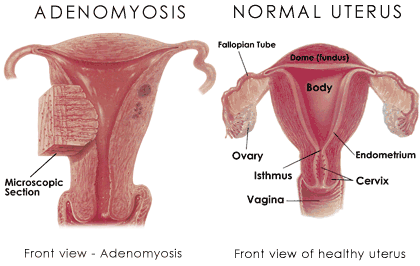Adenomyosis is a condition that affects many women around the world, yet it often remains misunderstood. In this article, we'll delve into what adenomyosis is, its symptoms, possible causes, and various treatment options available.
What is Adenomyosis?
adenomyosis is a medical condition where the inner lining of the uterus (endometrium) breaks through the muscle wall of the uterus (myometrium). This can result in pain, heavy menstrual bleeding, and discomfort.
Symptoms of Adenomyosis:
- Menstrual cramps that are more severe than usual
- Prolonged menstrual bleeding
- Heavy menstrual bleeding
- Pain during intercourse
- Pelvic pressure and discomfort
Causes of Adenomyosis:
The exact cause of adenomyosis is still unknown, but several factors may contribute to its development:
- Hormonal imbalances, particularly an excess of estrogen
- Inflammation of the uterus
- Prior uterine surgery, such as a cesarean section or fibroid removal
- Childbirth
Diagnosis of Adenomyosis:
Diagnosing adenomyosis can be challenging because its symptoms overlap with other conditions like endometriosis and fibroids. However, the following diagnostic methods may be used:
- Pelvic exam
- Ultrasound
- Magnetic resonance imaging (MRI)
- Biopsy (rarely performed)
Treatment Options:
- Pain Medication: Over-the-counter pain relievers such as ibuprofen can help alleviate discomfort.
- Hormonal Therapy: Birth control pills, hormone-containing intrauterine devices (IUDs), or hormone therapy may be prescribed to help regulate menstrual cycles and reduce symptoms.
- Surgical Intervention: In severe cases or when other treatments fail, surgical options such as hysterectomy (removal of the uterus) or uterine artery embolization (blocking the arteries that supply blood to the uterus) may be considered.
- Lifestyle Changes: Eating a healthy diet, exercising regularly, and managing stress can help alleviate symptoms.
Living with Adenomyosis:
Living with adenomyosis can be challenging, but there are steps you can take to manage the condition and improve your quality of life:
- Communicate openly with your healthcare provider about your symptoms and concerns.
- Explore different treatment options and find what works best for you.
- Seek support from friends, family, or support groups to cope with the emotional aspects of living with a chronic condition.
Conclusion:
Adenomyosis is a common yet often misunderstood condition that can significantly impact a woman's quality of life. By understanding its symptoms, causes, and treatment options, individuals can take proactive steps to manage the condition and improve their overall well-being. If you suspect you may have adenomyosis, consult with your healthcare provider for proper diagnosis and personalized treatment.
